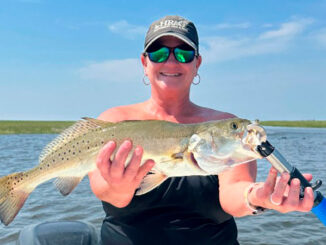
Citing an urgency to end the steady decline of spotted seatrout spawning recruitment in Louisiana since 2011, the Fly Fishers International (FFI) Gulf Coast Council today announced its support of an increase to a 14-inch minimum size limit. The proposal is one of several that Louisiana Department of Wildlife and Fisheries marine biologists have offered as a means of combating an existing deficit in seatrout spawning recruitment.
“The primary problem is a very low number of ages 2 and 3 female trout, the primary spawners,” said Glen ‘Catch’ Cormier, Conservation Director for FFI-GCC. “A minimum size of 14 inches solves that problem by increasing the total female spawning biomass by 20 percent. In fact, among the 10 states that manage for spotted seatrout, Louisiana is the only one with a minimum size limit less than 14 inches.”
The FFI Gulf Coast Council was part of a broad coalition of organizations that supported more conservation-oriented changes in seatrout management this past year in Florida and Alabama.
“Scientists across the Gulf Coast are recognizing that without protection of the primary seatrout spawning population, overfishing will continue to be a problem as fishing participation rises and anglers become more efficient,” Cormier added. “Having a 14-inch minimum size gives us a long-range safety net.”
While the FFI Gulf Coast Council would much prefer to see a reduced daily creel limit of 15 or 20 fish, the 14-inch minimum would suffice with the current limit of 25 fish, according to LDWF biologists.
FFI-GCC President A.J. Rosenbohm added, “While there are environmental issues at play here, it only reinforces the need for rule changes. Restoring our marsh will take time. Time is something we don’t have for speckled trout.”


